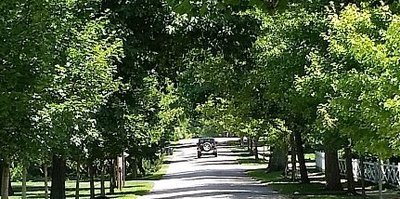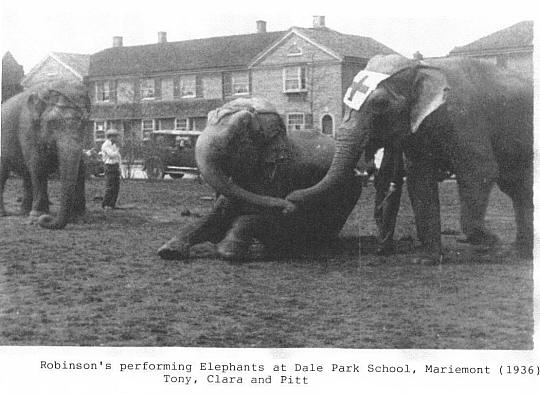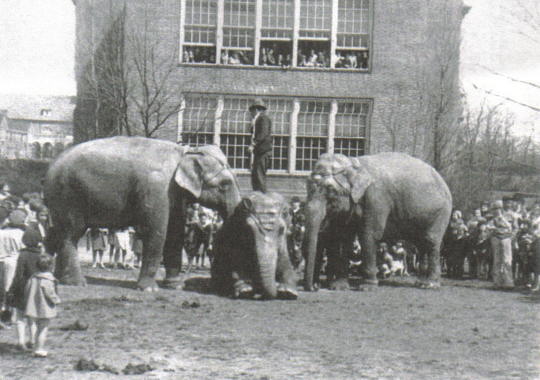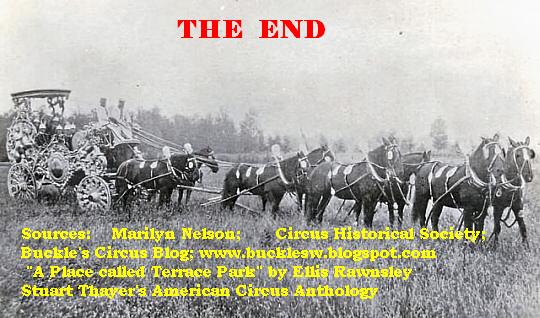All About the Robinson Circus
By Erin Purcell
When we think of American circus capitals today, we often think of places in Florida and Oklahoma, where many of the country’s largest circuses make their home. However, the scene was quite different one hundred and twenty years ago. Back then, the largest and most popular touring spectacle was the John Robinson Circus, and its winter headquarters were in Terrace Park, Ohio.
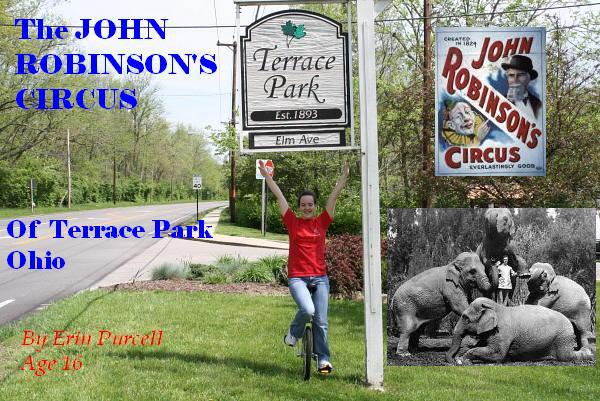
As a kid growing up in Terrace Park, a small suburb outside Cincinnati, I can’t remember a time when the Robinson Circus wasn’t part of my life. My grandmother’s great Aunt Em was a close companion of Lenora Robinson, the wife of the third John Robinson. Through Lenora, much circus lore has passed down through my family. I can remember sitting on my grandmother’s bed when I was little, listening to stories of lions and tigers and elephants roaming the streets that I had walked to school on earlier that morning. She would tell us stories of the clever, spunky elephants that had made their home in our quiet community. I was enthralled by it all.
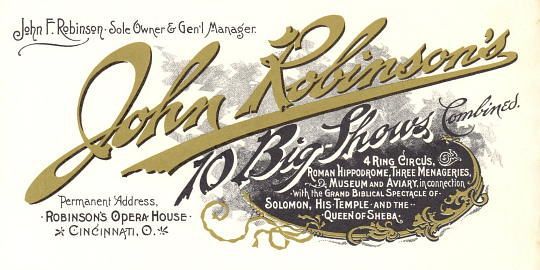
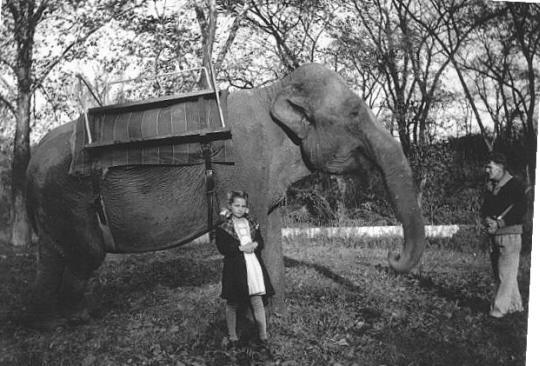
As I grew older, I came to see that the whole community regularly celebrated its circus history. My grandmother was invited to tell her circus stories to both my Girl Scout troop and my third grade class. In art class at elementary school, we made paper mache circus animals, along with their own cardboard cages. We created pastel and watercolor pictures of exotic animals in colorful caravans. The posters and banners of the Terrace Park Historical Society feature elephants on a bright red and gold background. It is said that the people living closest to the Robinson headquarters still find animal bones when digging in their flower gardens. I’ve heard kids claim that they have found large animal teeth in the nearby creek. The John Robinson Circus has remained a proud aspect of Terrace Park’s heritage, something that every resident knows about and has participated in, at least to some extent.
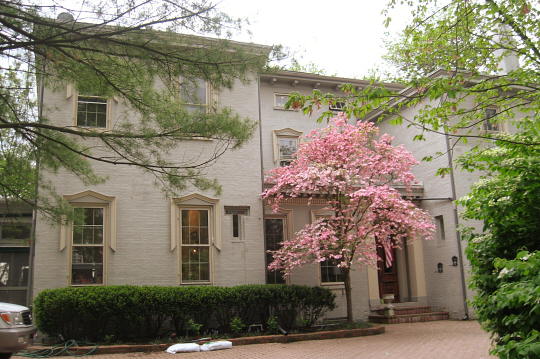
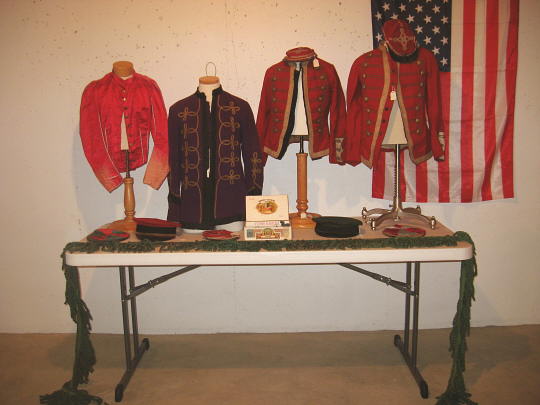
But what was the John Robinson Circus? Well, the short answer is that it was one of the most popular shows in the decades surrounding the 1890’s. It all started when a young man named John H. Robinson (the first of the four John Robinsons) was born in South Carolina in 1807 or 1808. Around age fifteen, John H. ran away from home and joined a small wagon show. He worked for many shows in his early years, including in order: Page’s Menagerie, Parson & McCracken’s Circus, Aron Turner, Stewart’s Amphitheatre, Hawkins’ Circus, Benedict & Haddock and the Zoological Institute. He must have started as a workman, because there is no record of him performing in a show until 1832, as a stilt dancer. It would be as an equestrian, however, that John H. would be remembered for his performing skills.
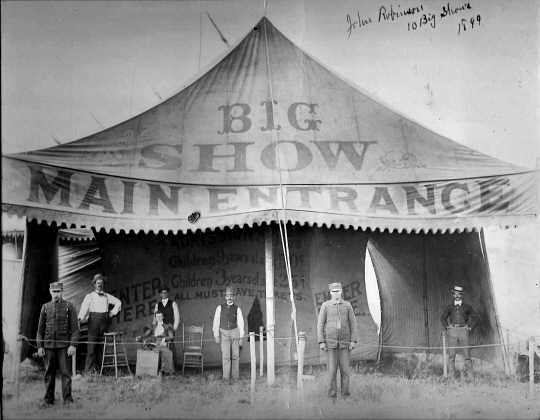
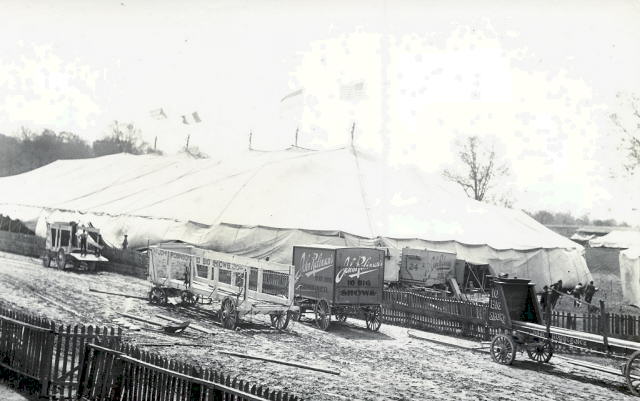
John H. continued to travel the country with small wagon shows, acting as a stilt walker, bareback rider, or manager. In April of 1842, John H. left the Ludlow & Smith circus to form his own circus with partner Joseph Foster. The great John Robinson circus was born. While the circus was playing a show in Kentucky around 1850, John H. developed an eye ailment and was referred to a specialist across the river in Cincinnati. As he began to build his own circus legacy, he decided to settle his family and his business in Cincinnati for the winter months, since he liked the area so much.
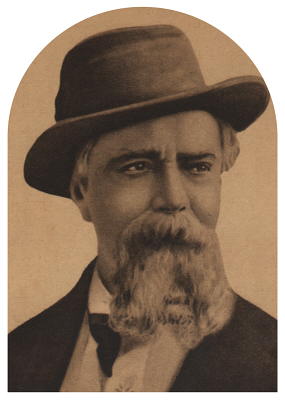
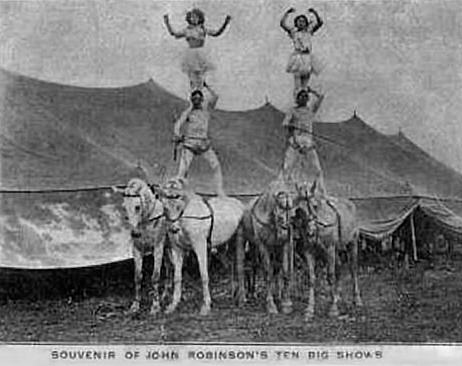
Like hair color or height, circus seems to run in families, and the Robinsons were no exception. John H., called Uncle John, was succeeded in ownership by his son John F., whose nickname was “The Governor”. Next was John G., called Papa, who was Lenora’s husband. Their son John IV worked in the circus business for a short while, though he eventually became an attorney. They were a colorful family, full of showmanship and circus quirk. It is rumored that The Governor, always a showman, would hitch a team of twelve horses to a wagon on Sundays when he went out to buy his morning paper!
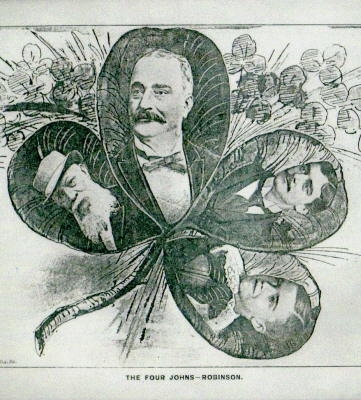
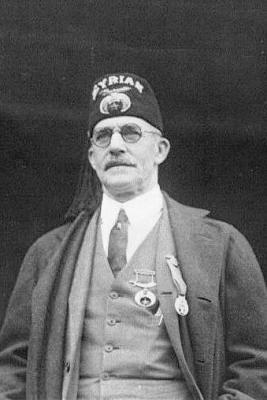
The Robinson circus continued to grow. It started out touring in wagons, and, like all wagon shows, there were many frustrations. Wheels got stuck in mud, and had to be pulled up by the elephants. Traveling was slow. Winds, floods, and fires were constant dangers, along with local town drunkards who would stagger in to stir up trouble. Oftentimes one of the ruffians would attempt to rob the ticket box. The Robinson solution? Lenora, John III’s wife, would travel home at the end of the week, the money box planted firmly under her feet and a small pistol tucked into her purse.
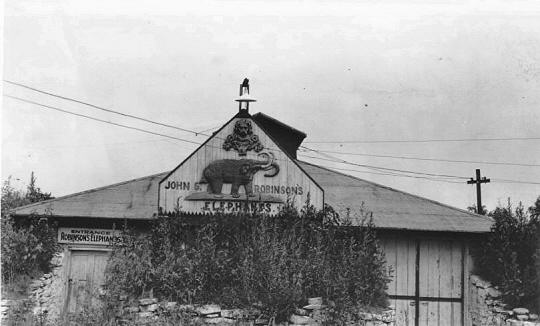
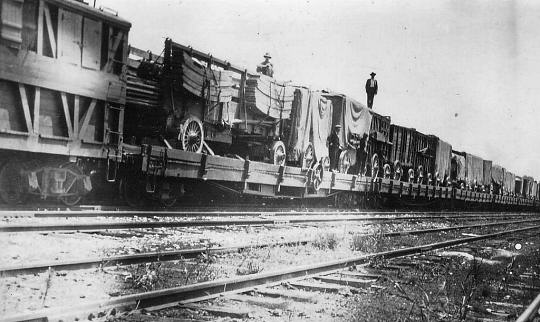
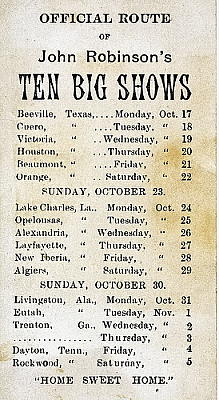
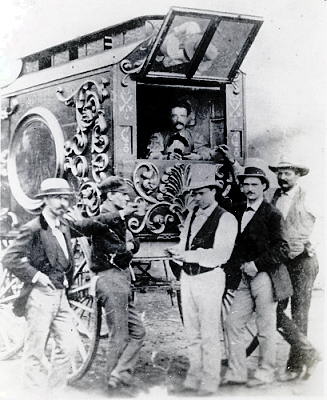
After wagons, boats were used for a short time in the 1870’s, and then the move was made to railroad cars. The Robinson circus became the one of first circuses in the country to own its own railroad cars. At the zenith of the Robinson circus in the 1890’s, at least thirty-five cars were needed to transport the entire company. It was clear that the Robinson contingent was staggeringly large; it was once billed as “Robinson’s Circus, Menagerie, Museum and Aquarium”. The Robinson show was also one of the first circuses to have two large tents, one for the circus acts and one for the menagerie, and to build its own billboards and to own its own cookhouse wagon.
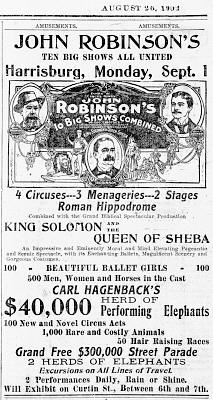
One of the most famous spectacles throughout the Robinson circus’s run was entitled “Solomon and the Queen of Sheba”. The dazzling scenery was designed by John Rettig, and the show was directed by Charles Constantine. This colossal production had a cast of at least three hundred, with one hundred girls dancing in the ballet alone. A period piece such as this was a prime opportunity to showcase the exotic camels, lions, elephants, tigers, and other animals that were accumulated in the menagerie. Trapeze artists, jugglers, tightrope walkers, and acrobats filled the rings. “The Queen of Sheba”, along with other historical pageants, is particularly remembered as one of the most stunning Robinson productions.
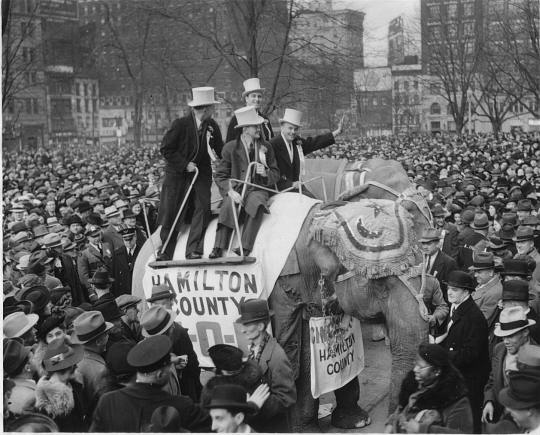
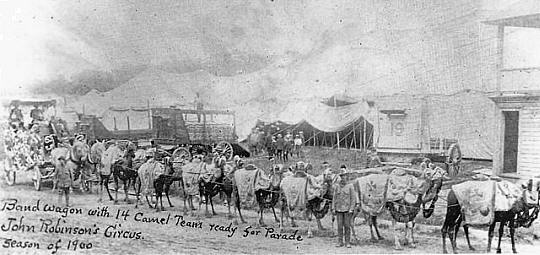
A phrase you might hear while hanging around circus people is, “give ‘em a John Robinson”. Though the exact circumstances under which this saying was invented are not clear, its general meaning is agreed upon. An owner or manager might say, “give ‘em a John Robinson” when a storm is approaching, or there is a long jump to the next town. It is a signal to cut tricks from the acts so that the show can be over with and packed up quickly.
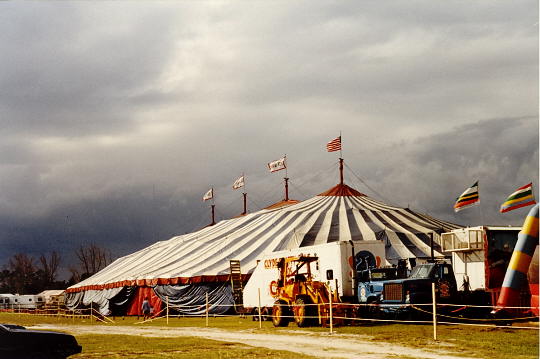
Of course, the true heart of any circus is often in the performers themselves. The Robinson circus was certainly not hurting for interesting characters. Between 1840 and 1893, Dan Rice was the most famous clown of the era. He wore white face paint, satin capes, and carried a large book of Shakespeare. Then there was the snake charmer named Leander Millward, who loved snakes so much that he would stick his bare hand down holes in search of rattlesnakes at the railway stops. His love for the animals backfired, however, when one of them gave him a “kiss” on the nose, and he died from the poison.
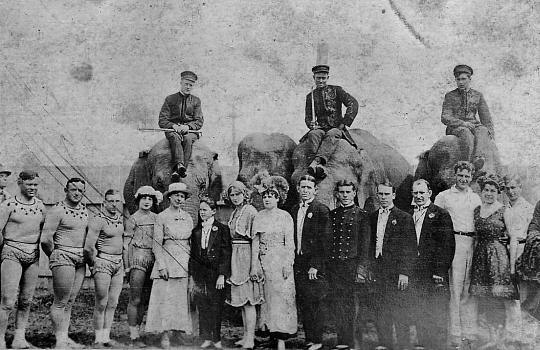
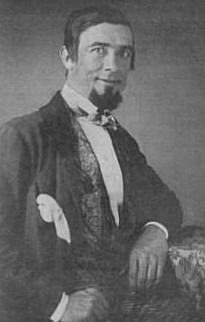
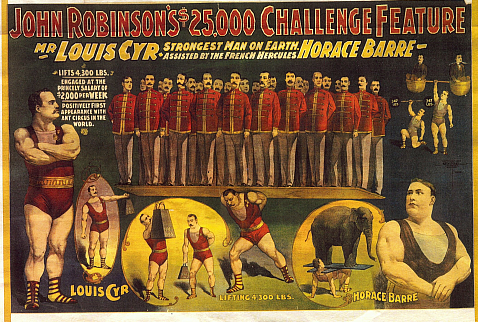
The Robinson circus even kept the excitement going during the winter months, when it made its home in the quiet town of Terrace Park. One evening, a couple was sitting on their back stoop, plucking a chicken for supper. They were terrified to look up and see a lion prowling across the backyard toward them. Fortunately, they ran inside (leaving the chicken for the lion) and Robinson workers soon arrived to collect their escape artist. There was also a time when a black panther was on the loose, and all the children had to be kept in school until it was found and returned. The camels, for reasons unknown, were always rehearsed in the streets during the nighttime, giving the neighborhood insomniacs quit a show!
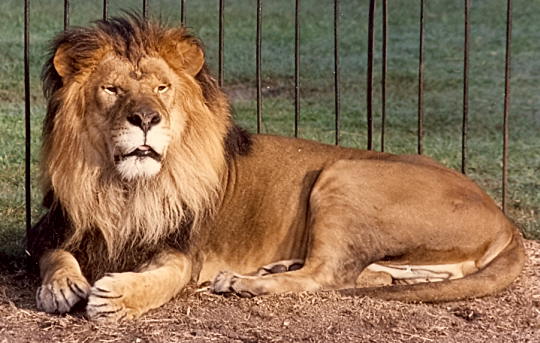
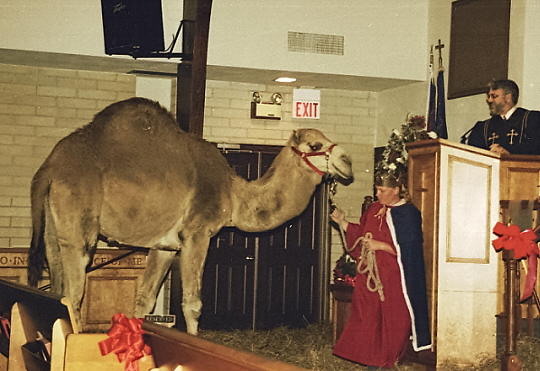
Though all types of circus animals can be entertaining, John G. Robinson felt that there were no animals better than the elephants. He worked very closely with the elephant trainers, and the pachyderms became the pride of his circus. The most famous Robinson elephant act involved the “Military Elephants” firing cannons, maneuvering in military formation, and taking care of the “wounded” in battle.
The elephants also contributed to the excitement in Terrace Park. One day, some motorists noticed an elephant walk into an open field. Two more quickly followed it. Soon there was a crowd gathering to watch the herd of elephants that was emerging from the woods. When John F. heard what was going on, he told the elephant trainers to give an impromptu show right then and there. The show was so popular that a practice ring was actually built in that field, now known as “the elephant hole”. The elephants became accustomed to giving shows to the passing public most days free of charge.
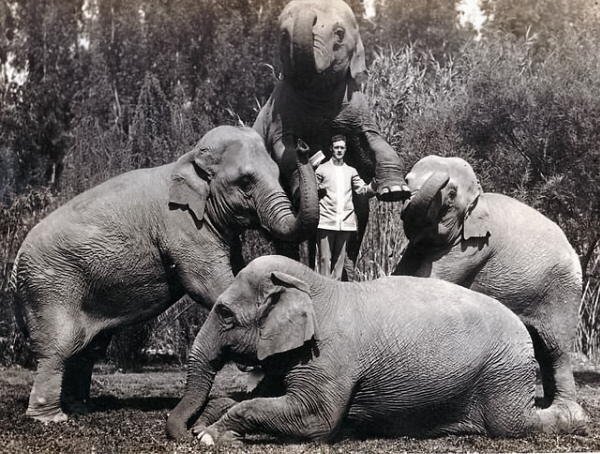
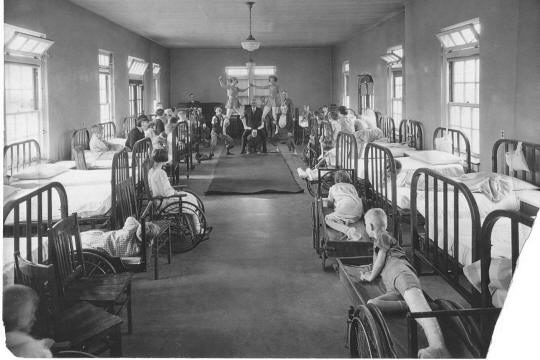
Though the elephants were entertaining, they certainly caused some mischief. There was a time when a man from Terrace Park was supposed to lead a meeting in Chicago. However, he missed his train due to an “elephant crossing” taking place on one of the main roads! On a different morning, a man awoke to a shaking of his house, and thought they were experiencing an earthquake. It wasn’t until he looked out his window that he realized that an elephant was merely using the back of his house as a scratching post.
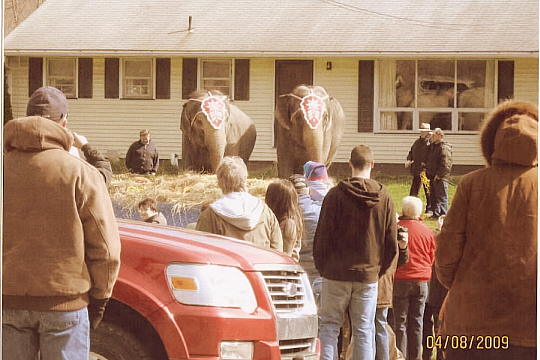
All the elephants were talented, there can be no doubt about that. However, everyone’s favorite was Tillie. She was first on the John Robinson Circus in 1872, and she certainly left her mark. There was the time when the elephants were pushing the wagons through the mud, and one of them was about to overturn. Tillie, of her own accord, broke ranks and ran to prop the wagon up until it was returned to dry land. She also stopped some railroad cars that had broken loose from running away down the tracks. There was also a time in North Carolina when an elephant named Charlie killed his trainer and escaped, rampaging through the streets. Tillie followed after him and then sat on top of him until workers came to contain him. Tillie was the obvious leader of the Robinson elephants. She led the act when they were inside the ring, and kept everyone else in check outside of it.
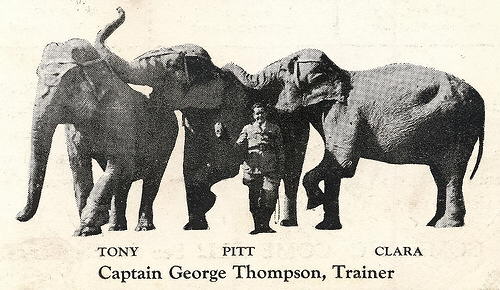
John G., the third John Robinson to own the circus, had a particular fondness for Tillie. Stories say that he taught her to call him “Papa”. Whenever she wanted him, she would call out his name, and he would come running. It is said that Tillie called out, “Papa” right before she died, at the ripe old age of one hundred and twenty. Her funeral was a civic event, involving the entire village. School was cancelled, and the children staged a pageant. A private plane dropped flowers from overhead, and the Cincinnati Enquirer carried a full obituary. Tillie’s remaining elephant friends, Tony, Pit, and Clara, fired a military salute with the canons from their act. Though Tillie’s tombstone is placed in the garden of 1 Circus Place, the Robinson’s old home, she was definitely too large to have fit in a grave there. The location of Tillie’s burial is still one of the great Terrace Park mysteries.
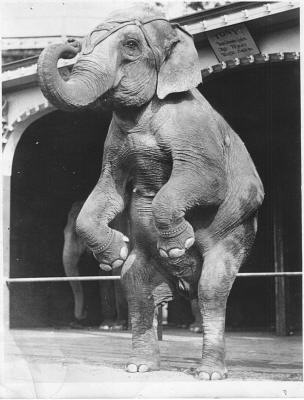
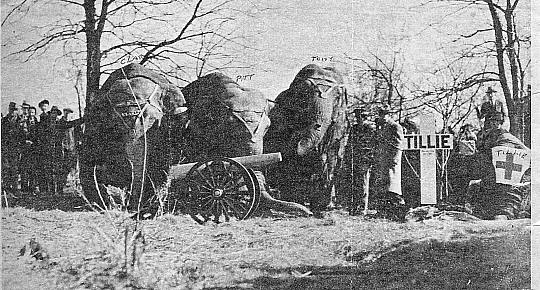
Circus publicity was often greatly exaggerated as is this claim of Tillie having reached the age of 120 years. Noted circus historians set her age at time of death to be around 65.
Tough economic times surrounding the First World War eventually caught up with the Robinsons. After a bank that John G. had invested in failed in 1916, he was forced to sell nearly his entire show to the American Circus corporation of Peru, Indiana, who in turn were later bought out by Ringling Brothers circus. However, he maintained the four elephants, Tillie, Tony, Pit, and Clara at his home in Terrace Park.
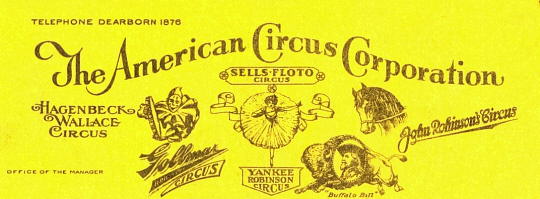
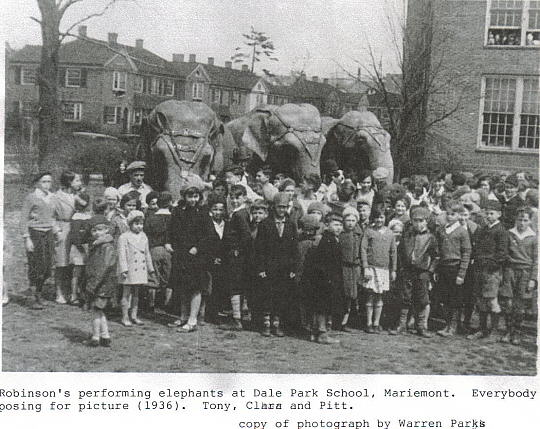
The Robinson circus has certainly been one of the most influential and exciting circuses in American history. It was a part of the “great wagon show days”, and paved the way for circuses that would come after it. I know that being the winter home of the former Robinson circus continues to be a source of fun and pride for Terrace Park residents, and I hope that other people will still get a kick out of the Robinson antics. We are proud to have been a small part of this stop on the show route of American circus history.

